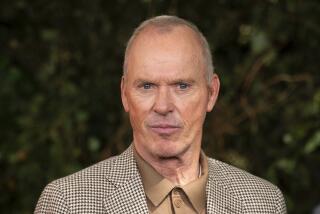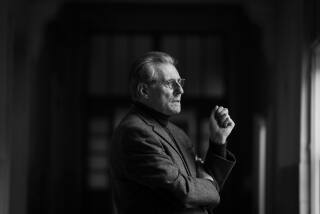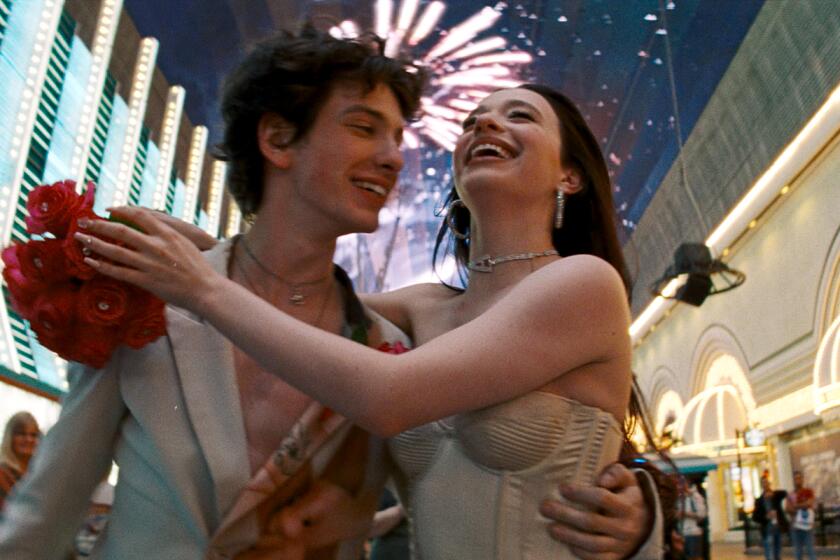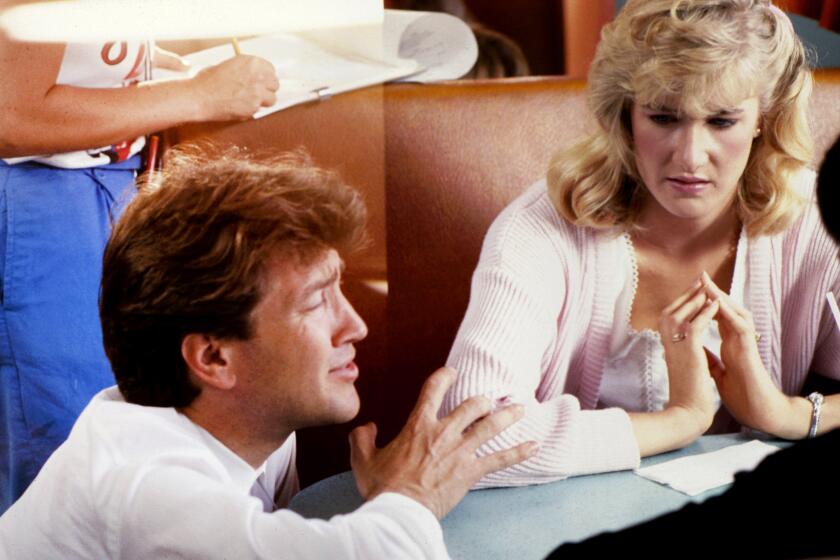COVER STORY : His Silents Are Golden : Buster Keaton’s name, like the laughter that his classic films evoke, reverberates around the world on the 100th anniversary of his birth.
- Share via
It always comes back to the face, the Great Stone Face, a face, it’s been said, “that asks to be left alone.” Samuel Beckett had it in mind when he wrote “Waiting for Godot,” and critic James Agee believed it “ranked almost with Lincoln’s as an early American archetype; it was haunting, handsome, almost beautiful.” It’s a face that continues to astonish, even today.
“Wherever I go, there’s a great deal of speculation about whether he could actually smile or not,” says Eleanor Keaton, Buster Keaton’s widow, smiling herself. “The answer was yes, as long as there weren’t any cameras around.”
This year, with the 100th anniversary of Keaton’s birth, the most expressive blank face in film history has been getting special attention. A new biography, “Buster Keaton: Cut to the Chase” by Marion Meade, has just been published; a new documentary on his life will air Dec. 11 on the A&E; channel; Kino on Video has issued a comprehensive 10-cassette series called “The Art of Buster Keaton,” and film festival tributes are going on worldwide in cities that include Berlin, Rio de Janeiro and New York.
And, Thursday night at 8, in collaboration with the AFI/Los Angeles Film Festival and the L.A. County Museum of Art (whose own nine-week Keaton retrospective begins Saturday), the Academy of Motion Picture Arts and Sciences gets into the act. “An Academy Tribute to Buster Keaton” will feature 75 minutes of superb clips, plus a conversation between Eleanor Keaton and silent film authority Kevin Brownlow, who is flying in from London just for the event and whose 1987 “Buster Keaton: A Hard Act to Follow” documentary, made with David Gill, remains the best look at the man.
*
One of the twin pillars (along with Charlie Chaplin) of silent film comedy, Buster Keaton had an unusual combination of talents that has helped his reputation do nothing but rise since his death in 1966. He brought an engineer’s mind and a poet’s sensibility to slapstick, ending up, in critic Peter Hogue’s words, with “some magical and unlikely wedding of surrealism and Yankee pragmatism.”
And James Agee, whose 1949 essay in Life magazine, “Comedy’s Greatest Era,” began the Keaton revival, was even more lyrical: “In a way his pictures are like a transcendent juggling act in which it seems that the whole universe is in exquisite flying motion and the one point of repose is the juggler’s effortless, uninterested face.”
What is even more remarkable is that, alone among the silent clowns, the spareness of Keaton’s work has an exquisitely modern feeling about it. None of his contemporaries, and that definitely includes Chaplin, has managed to remain as outside of time as he does. No matter what happened to Buster’s character, and extreme scenarios were his specialty, he never got over-emotional about things, never rolled his eyes or pleaded for the audience’s sympathy. Rather, like a comic philosopher of despair, he accepted the world and his lot in it and tried to make the best of an increasingly preposterous situation.
“Everything was so clean and pure and mathematically correct, there was never anything sloppy,” says Eleanor Keaton of her husband’s work and its continuing appeal. And Patty Tobias, president of a Keaton appreciation society with members in nations as distant as Iceland, Pakistan and New Zealand, says film professors prefer to use Keaton to introduce the genre to students because “his films don’t do what people stereotype silent comedies as doing.”
If Keaton could be around to see all this fuss, says Eleanor Keaton, “he would be in total shock. He wouldn’t believe it--in fact he didn’t believe it when his films first started coming back.” She says Keaton was similarly indifferent to efforts by a zealous entrepreneur named Raymond Rohauer to preserve his silent comedies: “He just didn’t know what good it would do.”
To understand this point of view, Eleanor Keaton emphasizes, you have to understand the attitudes prevalent when Keaton was in his prime. Movies were a new form considered as ephemeral and disposable as Kleenex. Even Buster’s father, Joe, an old vaudevillian, had contempt for the medium, telling people: “You’re not going to put my act on a bedsheet for 10-cent admissions.” Keaton’s films were originally created, his widow emphasizes, strictly to make money for the short period it took until the next one would be ready, “and that would be the end of them. This kind of interest, Buster couldn’t visualize it.”
Keaton was similarly uncomfortable about the post-Agee critical fuss that examined him in rarefied terms, memorably telling one interviewer, “No man can be a genius in slap-shoes and a flat hat.”
“He didn’t have a big ego, he was never impressed with himself, he’d performed from the time he was 4 years old and this was all in a day’s work for him,” Eleanor Keaton remembers. “Geniuses were great thinkers to him; he thought calling him that was unreliable information.”
Still, Keaton took considerable pride in the craft aspects of his work, in knowing what was funny and how to make it happen on screen. “He’d talk about what a delicate operation it was having the whole 6,000-pound side of a building fall on him in ‘Steamboat Bill Jr.,’ ” Eleanor Keaton says. “He had 2 1/2 inches of clearance on each shoulder and four inches clearance on his head for his body to get through an open window. His mark was a brass nail pounded in the dirt. If he didn’t hit it, that would be all she wrote.”
*
An added factor in Keaton’s uneasiness with acclaim was personal. “He was extremely shy, he did anything to keep away from the limelight,” his widow remembers. “He especially couldn’t stand mobs of people coming at him. At a showing of his films at the Cinematheque Francaise in Paris, the lights went up and he took off up the aisle in as close to a dead run as he could get. When I finally caught up to him, he was in an alley, upchucking his dinner.”
Part of Keaton’s shyness came from embarrassment at his almost complete lack of formal schooling; he had lasted half of a single day, and later was taught to read and write by his mother.
A child of knockabout vaudeville, Joseph Frank Keaton was almost literally born in a trunk Oct. 4, 1895, and officially joined the family act when he was 4. His father soon billed him as “The Little Boy Who Can’t Be Damaged” and his nickname, Buster, was related to his ability to take the kinds of daunting falls the act demanded.
It was an old vaudeville pal, Roscoe (Fatty) Arbuckle, who introduced Keaton to two-reel comedy in 1917, and he took to it immediately. Within four years he was starring in his own two-reelers and, in 1923, Keaton began a remarkable string of a dozen silent features in seven years, including such classics as “Sherlock Jr.,” “The Navigator,” “Seven Chances,” “Go West” and Keaton’s personal favorite, “The General.”
What Keaton--and the team of gagmen he never worked without--brought to these films was a lifetime of experience in humor that led to surprisingly sophisticated methods of engaging viewers. “I always wanted the audience to outguess me,” he told one interviewer, “and then I’d double-cross them.”
Equally important was Keaton’s exceptional physicality, a preternatural grace and agility that the actor, who never used a double in his prime, refused to fake. His astonishing stunts were often as dangerous as they looked. Keaton broke his neck in “Sherlock Jr.” but didn’t know it until years later. How close he came to being drowned doing a stunt in “Our Hospitality” can be seen in the finished film: his cameramen were told to keep shooting no matter what.
*
Then everything changed. At roughly the same time that sound came in, financial reasons led Keaton to forsake his independent status and sign a contract with mighty MGM. The studio neither understood nor particularly appreciated his talent, and the frenzy for talking pictures made it impossible for executives to let Keaton be purely himself.
“He was bitter at MGM--he just hated it so much being there,” Eleanor recalls. “He said they’d put as many as 17 writers on one of his films, all of them working on jokes for him. That drove Buster up the wall.
“ ‘You can talk, I can talk, anybody can talk,’ he’d say. ‘Why don’t they just give me five minutes to do something by myself?’ But he had no choice. He didn’t own his own company; it was either do that or not work.”
One of Keaton’s few pleasures of those years was his passion for bridge. It was through her own desire to learn the game that a teen-age Eleanor Norris, a dancer at MGM in 1938, met Keaton, the veteran of a pair of unhappy marriages and several serious battles with alcoholism. Not until some months later, when she “lashed out at” someone who was rude to her at the table, did Keaton notice her, she says; “before that I was just a pair of hands holding cards to him.”
In 1940, when Norris was 21 and Keaton was 44, they decided to get married.
“A lot of his friends worked me over pretty good about that,” Eleanor Keaton remembers. “His doctor, an Army colonel, worked on me for about an hour one day, telling me Buster didn’t need to go through anything more, he’d had enough.
“I listened politely and ignored them. I knew Buster’s temperament and his character by then. And when you love somebody, you forget what other people say.”
Now a vibrant, energetic 77, Eleanor Keaton still has the forthrightness and agreeably no-nonsense personality that must have attracted Buster.
“I’m a yammerer and a gabber and he was quiet,” she says. “He hated confrontation. He would just walk away from it.”
The couple were a good fit in other ways. “I was never young,” Eleanor Keaton says matter-of-factly. “My father was killed when I was 10 and I went to work when I was 14. I never went through that giggly, teen-age thing; I went from child to adult overnight.”
Keaton, by contrast, “ever since he became a star, liked to have a flock of people take care of him. He was never ever alone, never forced to deal with things. When we lived in Woodland Hills, which was just a town of 15,000 then, he’d walk out of stores without paying; the owners knew I’d be following along.
“He’d come to me once a year, the week before Christmas and say, ‘Give me a check.’ I’d give him one and he’d tell me to sign it. ‘You can sign it,’ I’d say. ‘You’re on the account.’ He didn’t even want to get that involved. Money didn’t interest him. If he had enough to buy what he wanted, he didn’t care.”
Keaton’s marriage to Eleanor Norris, which had lasted more than 25 years by the time he died at age 70 in 1966, was by all accounts the key factor in changing his life for the better. When TV and its live audiences became popular, Keaton, who viewed the medium as vaudeville reborn, became a frequent guest on comedy shows. He also worked consistently in commercials, had parts of varying sizes in everything from “Sunset Boulevard” to “How to Stuff a Wild Bikini” and lived long enough to get a special Academy Award and have a forgettable biopic made about his life.
Buster Keaton was buried with a rosary in one pocket and, at Eleanor Keaton’s suggestion, a deck of cards in the other. “He had to have a deck, he was never without one,” she says with her usual matter-of-factness. “That way, wherever he was going, he was ready.”
* “An Academy Tribute to Buster Keaton” will take place Thursday at 8 p.m. at the film academy’s Samuel Goldwyn Theater, 8949 Wilshire Blvd., Beverly Hills. Tickets are $6. Information: (310) 278-5673.
(BEGIN TEXT OF INFOBOX / INFOGRAPHIC)
A Tribute Fit for a ‘General’
The L.A. County Museum of Art’s Buster Keaton series will take place at the museum’s Bing Theater, 5905 Wilshire Blvd., just east of Fairfax Avenue. Tickets are $6 and $4. For information, call (213) 857-6010.
The schedule:
Saturday: “Steamboat Bill, Jr.,” “The Scarecrow,” “Convict 13,” “My Wife’s Relations.”
Nov. 11: “Seven Chances,” “College,” “The Haunted House.”
Nov. 18: “Our Hospitality,” “Neighbors,” “The Blacksmith,” “Day Dreams.”
Nov. 25: “Three Ages,” “Sherlock Jr.,” “The Playhouse.”
Dec. 2: “The Navigator,” “The Boat,” “The Balloonatic,” “The Love Nest.”
Dec. 9: “Go West,” “Cops,” “Hard Luck,” “The Frozen North.”
Dec. 16: “Battling Butler,” “One Week,” “The Paleface,” “The Electric House.”
Dec. 23: “The General,” “The High Sign,” “The Goat.”
Dec. 30: “The Cameraman,” “Spite Marriage.”
More to Read
Only good movies
Get the Indie Focus newsletter, Mark Olsen's weekly guide to the world of cinema.
You may occasionally receive promotional content from the Los Angeles Times.











